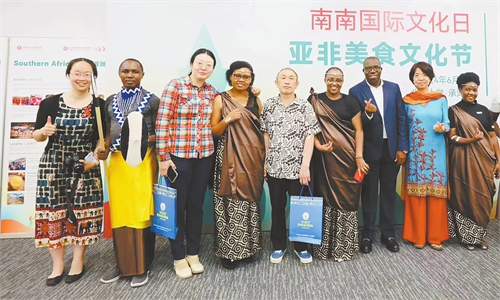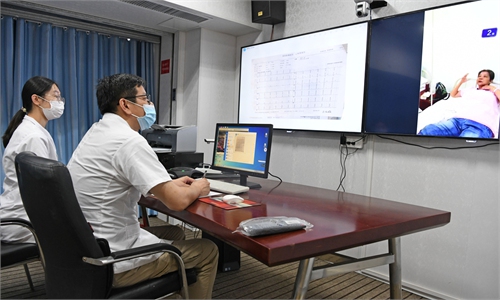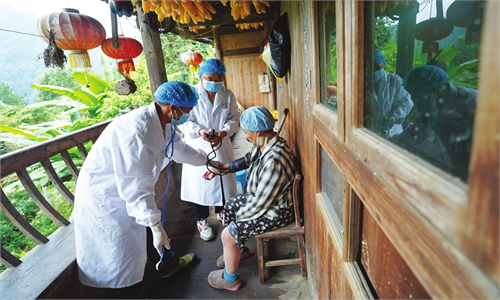IN-DEPTH / IN-DEPTH
African countries leverage China’s expertise in collaborative fight against malaria
Innovative disease control
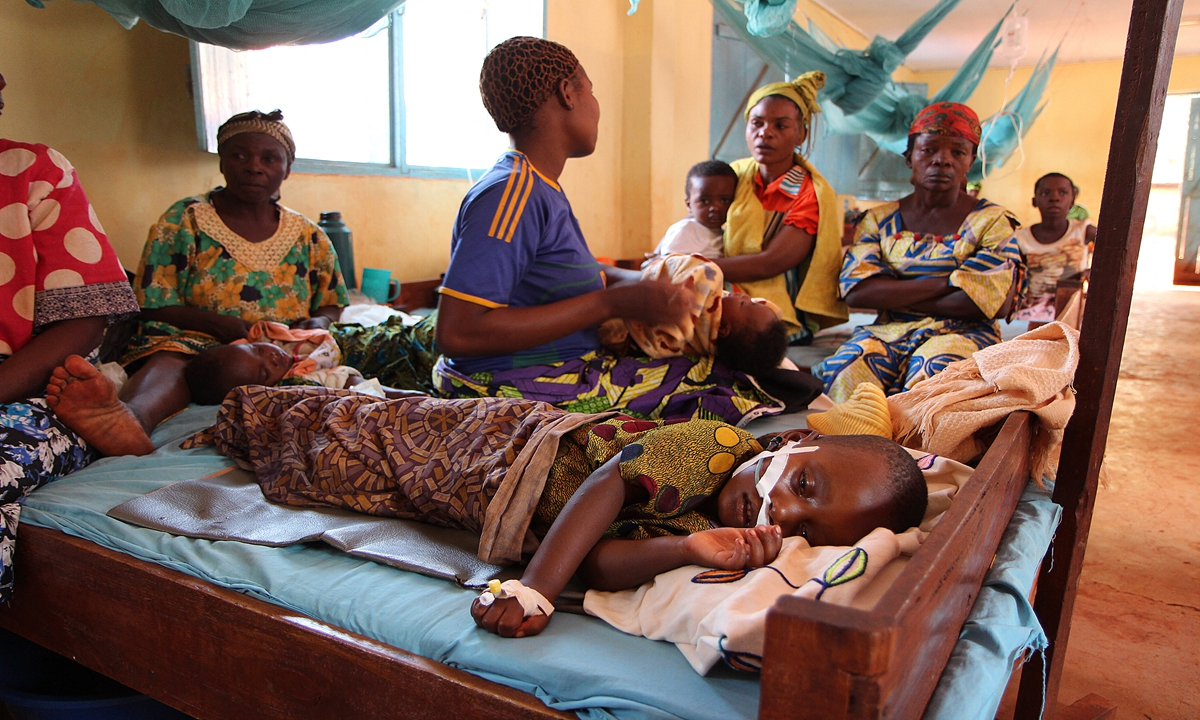
A child suffering from malaria lies on a bed at the hospital of Nyarugusu, in north west of Tanzania, on June 11, 2015. Photo: AFP
Editor's Note:The 2024 Forum on China-Africa Cooperation (FOCAC) Summit will be held in Beijing from September 4 to 6. The theme of this year's summit is "Joining Hands to Advance Modernization and Build a High-Level China-Africa Community with a Shared Future." In light of this key event, the Global Times launches a series of China-Africa stories, including interviews with political leaders, stories of exchanges between young people from China and African countries, and intensive cooperation in various fields. Through these stories, we will see how China and Africa are deepening their ties and building a brighter future together.
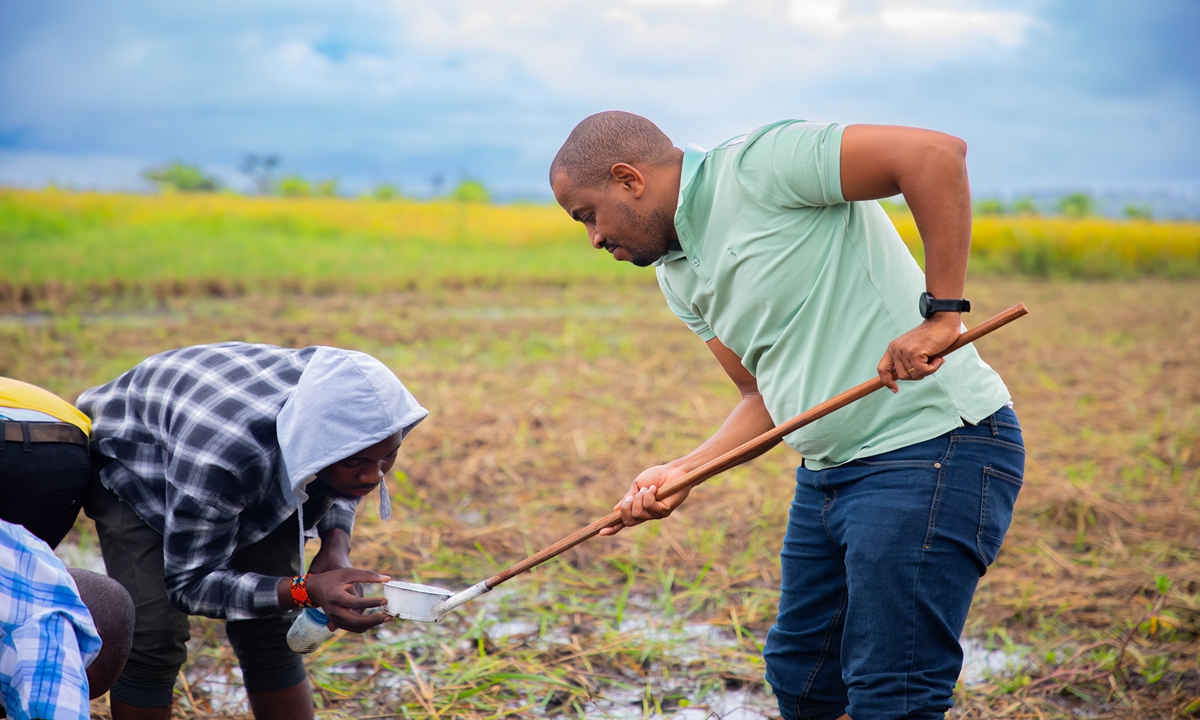
Yeromin Mlacha scoops mosquito larvae from breeding habitats, a crucial step in malaria control efforts in Tanzania. Photo: Courtesy of Yeromin Mlacha
Since an early age, Yeromin Mlacha has had a special interest in the study of mosquitoes. As he grows older, he dreams of eliminating malaria - a life-threatening disease spread to humans by some types of mosquitoes - in his home country Tanzania, where the disease has caused many deaths.Mlacha now works as a vector biologist at the Ifakara Health Institute. The institute got its name from the Tanzanian town of Ifakara, which was known as "the place to die" in the local language due to its history as a malaria hot spot. Mlacha's institution aims to improve local people's health and well-being through research, education and service, particularly in the fight against malaria.
According to statistics from the World Health Organization (WHO), there were 249 million cases of malaria in 2022 in the world and the estimated number of malaria deaths stood at 608,000. In 2022, the African continent was home to about 94 percent of all malaria cases and 95 percent of deaths from the disease. Children under 5 accounted for about 78 percent of all malaria deaths in the continent. Tanzania is one of the African countries most affected by malaria.
In the course of his work, Mlacha has devoted much energy to studying how China has eliminated malaria, as he thinks it is of great value to learn from China's experience and lessons.
"China had successfully achieved malaria elimination by 2021 after decades of effort, which is a remarkable feat for a country that reported 30 million cases annually in the 1940s," he said.
Zhou Xiaonong, chief scientist on parasitic diseases control at Chinese Center for Disease Control and Prevention (China CDC), told the Global Times that China is playing a crucial role in the fight against malaria in Africa, having aligned its efforts with the United Nations Sustainable Development Goals and the African Union's Agenda 2063.
Zhou explained that through the collaborative efforts between the National Institute of Parasitic Diseases (NIPD) at China CDC and international partners such as the WHO, China has been instrumental in establishing a comprehensive framework for malaria control and elimination across Africa.
Lessons to learn
According to Mlacha, among all the measures that China had taken, it is most notable that China pioneered a surveillance and response strategy known as "1-3-7," which shortened the time between local health authorities reporting malaria cases and the beginning of testing others for exposure to the disease.
Under this system, health facilities must report a malaria diagnosis within one day, with health authorities confirming the case and assessing the risk of spreading by Day 3, and implementing preventive measures within seven days to contain the disease.
However, the direct use of the method in Tanzania later turned out not to have achieved the desired outcome. They encountered two major challenges.
"First, the model requires on-site investigations within three days, necessitating a comprehensive address system, which we lack. Second, the model is primarily designed for low-endemic areas and focuses on individual cases," Mlacha said. "However, in Tanzania, with its high malaria prevalence, health facilities report many cases daily, often from various villages."
"We need to tailor the program to the local context. By drawing on China's experience and expertise, along with input from our team of social scientists, we were able to translate the context of China into our own setting, making it more relevant and taking ownership of the message within the Tanzanian community," he told the Global Times.
After extensive research, Mlacha's institute, in collaboration with the NIPD, decided to revise the "1-3-7" model by removing the "3" component. In Tanzania, 95 percent of cases are locally transmitted, unlike in China. This difference led to the decision to eliminate on-site investigations to determine the origin of cases due to limited resources.
The updated model, known as "1,7 malaria reactive community-based testing and response (1,7-mRCTR)," focuses on tracking villages instead of individual cases. Health facilities will now report cases based on the villages of origin, identifying the three villages with the highest malaria incidence in the last seven days. Trained community health workers will then visit these villages to conduct testing and provide treatment.
Under the new system, community health workers will set up temporary stations in the identified villages and offer free malaria screening to all residents. Those who test positive will receive anti-malarial drugs for free. This approach aims to streamline the process and target high-risk areas more effectively.
Mlacha believes that delivering educational messages tailored to different age groups is another crucial lesson from China in fighting malaria.
To engage young people, who comprise the majority of the population, Mlacha and his colleagues created the Malaria Cup soccer game in Ifakara, as local youth have a passion for soccer. This competition brings teams from different villages together, giving Mlacha and his colleagues an opportunity to educate numerous adolescents in one location simultaneously.
Through the use of diverse methods, their efforts have paid off. During the first phase of the project, Mlacha saw an 81 percent decline in malaria prevalence in two areas they selected in a 2-year intervention between 2016 to 2018.
When Mlacha and his coworkers expanded the project to three districts from 2019 to 2021, they faced new challenges such as the COVID-19 pandemic. Despite these obstacles, the overall prevalence in the three intervention areas was reduced by 55 percent.
Currently, Mlacha's institute is eyeing the third phase, with discussions ongoing among the governments of China, Tanzania, and Switzerland, Mlacha said.
He told the Global Times that the investment made by the Chinese government in malaria control has greatly contributed to the reduction and elimination of the disease in China. By contrast, many African countries have not invested in tackling their own health problems and rely heavily on donor-funded projects. "It is important to invest in health infrastructure and not solely depend on donor funding, as seen in China's successful approach," he said.
Meanwhile, African countries also learned from China's approach for preventing and controlling malaria which focuses on eradicating the source of infection and managing the spread of the disease. This approach is rooted in traditional Chinese medicine principles, which prioritize addressing the underlying cause of an illness rather than simply alleviating symptoms. Chinese scientists have successfully developed artemisinin-based combination therapies for treating malaria, which have shown significant efficacy, Xinhua reported.
In sub-Saharan Africa alone, it is estimated that some 240 million people have benefited from artemisinin-based combination therapy, read another Xinhua report in 2023.
Zero-malaria vision
Zhou told the Global Times that the first phase of China-Africa malaria control cooperation through NIPD, which spans from July 2015 to June 2018, focused on China-Tanzania pilot on malarial control financially supported by UK Department for International Development. This phase aimed to establish a sustainable framework for malaria control, enhance local capacities, and lay the groundwork for future collaborations.
Despite challenges in the initiative stage, the project had seen notable progress, including the formation of expert groups, regular coordination meetings, and the development of training materials. Results showed that the significant reduction of the local malaria burden was more than 80 percent in the end of the first-phase pilot after the "1,7-mRCTR" approach was implemented. The approach was tailored from China's surveillance and response systems in malaria elimination.
Building on the success of the initial pilot, from 2019 to 2023, the NIPD launched the "China-Tanzania Malaria Control Demonstration Project," further extending the reach and impact of the original initiative. Supported by the Bill & Melinda Gates Foundation, this project continues to utilize the "1,7-mRCTR" model and achieved remarkable results in reducing malaria prevalence continuedly from over 30 percent to around 3 percent of prevalence in intervention areas. This success has drawn the attention of experts from other countries and the WHO, who recommend further integration of this model into national and global malaria control strategies.
The fight against malaria continues and the "1,7-mRCTR" model has now expanded to more countries, including Zambia, Burkina Faso, and Senegal.
Zhou noted that the current project involves a broader multilateral effort under WHO and NIPD of China CDC supported by United Nations Peace and Development Trust Fund. The project, launched in January 2022, seeks to strengthen malaria surveillance and response capabilities in Zambia, Burkina Faso, and Senegal. It aims to validate the effectiveness of the "1,7-mRCTR" method across different African regions, further reducing malaria burdens through coordinated, multi-sectoral approaches.
Looking forward, Zhou said that China plans to conduct a systematic evaluation of the "1,7-mRCTR" model's implementation across various African countries, optimize the strategy to suit regional differences, and facilitate the translation of research findings into actionable policies. Besides, China aims to advance the development of innovative malaria control products, such as vaccines, drugs, and diagnostic tools, ensuring their global accessibility and affordability.
"China's commitment to malaria control in Africa underscores its broader goal of contributing to global health security and sustainable development. By fostering strong partnerships and leveraging innovative strategies, China is helping to pave the way for a malaria-free Africa," Zhou told the Global Times.
Despite its ominous name, Ifakara is now one of the safest places in Tanzania, with malaria nearly eliminated after years of cooperative efforts, according to Mlacha. Despite the foreseeable difficulties, he still has a zero-malaria dream for the African continent.
"I hope that the method we have learned from China and have implemented in Tanzania, combined with other measures such as long-lasting insecticidal nets, innovative antimalarial drugs, and vaccines, will help the entire African continent to achieve malaria elimination soon," Mlacha said with confidence.
